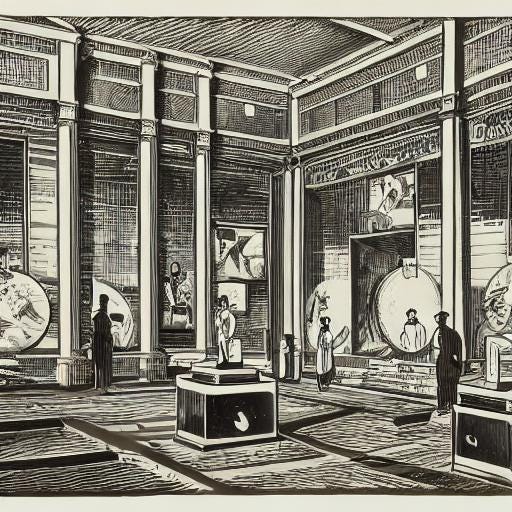What is 'Digital Learning' anyway?
What does 'Digital Learning' look like to cultural institutions in 2024?
The Digital Learning Network (DLNET) has been working with the cultural sector for many years, during which time technology and the way it is used by the public and by organisations has changed vastly. However, we have always advocated that cultural organisations shouldn’t focus on specific technology (either software or hardware), but that their collections, their programme, and their ‘real-world’ content was what made them so engaging in the first place. Technology can be a medium through which this content is delivered to an ever-widening audience. In addition, technology also offers us some opportunities to overcome barriers and to improve our practice in other ways.

Challenges to the Sector
The culture sector is not alone in facing challenges, in fact many of the challenges we face are not unique to us. However, our understanding of both established and new technologies can provide us with new opportunities, and enable us as individuals and as organisations to be better suited to face these challenges.
The challenges for our sector will inevitably affect digital learning and audience engagement, include issues that are both unique to culture, heritage and the arts, and those with a more global reach.
Fighting the global Climate Emergency.
Surviving public spending cuts to the arts in the UK and across Europe and beyond.
Addressing our colonial past.
Improving access to our institutions and our content, being inclusive in our practice and promoting diversity.
Can technology be used to overcome these challenges to make our work better and more meaningful, or will it only contribute further to the issues?
New technologies
Technology is evolving continually. It adapts as users seek new applications for existing technology but is also driven by responses that technology companies employ to maintain a competitive edge.
Whilst mobile and smartphone technology appears to be plateauing, other areas such as Virtual Reality, Augmented Reality and AI are new technological frontiers that have opened in recent years. The world of social media appears to continually evolve, but the keys that our sector need to harness this for engagement remain constant. It is easy for those of us drawn to the novelty of shiny new technology, to be blind to how everyone else is actually using it. Often, in respect of all technologies, it is important to be informed by how people use those tools in order for us to understand what the applications for our sector might be, and the core content of our organisations should be at the heart of what we offer. However, we will still find ourselves grappling with the questions of how changing technology will affect our work.
Our homes are now more ‘connected’ than ever, by employing ‘smart’ technologies in nearly every facet of our domestic life, but does this have applications for the sector in engaging cultural audiences too?
Digital Learning in the cultural sector
Digital Learning can mean many things to many people, even within our sector. The way we apply this might change according to the scale and size of our organisation, or to the existing ways that we engage our audience.
Most organisations were forced to improve the ways they engage their audiences digitally during the COVID-19 pandemic. But since the pandemic, have organisations continued to use the digital realm to the same extent, in terms of our audiences?
The sector is fairly universal in the way it uses websites to provide not only visitor information, but also more nuanced access into its content. Many also use social media, notably Facebook, X (formerly Twitter) and Instagram for more or less the same purposes. Some use digital kiosks in galleries or interpretation, some use audio tours either on dedicated equipment or via a smartphone app. Video conferencing was once quite rare, but is more common place now, partially because of advancements made during the pandemic.
Some larger organisations have teams of staff whose only roles are around digital engagement. Others have no dedicated digital staff, sometimes no dedicated engagement staff, and instead it falls to a single member of staff juggling many roles to fill this gap. It might be easy to think that bigger organisations, more staff, larger budgets mean that those organisations are ‘doing digital’ better, with newer technology and more expertise. However, new technology can take time for audiences to adopt, and smaller organisations can be more responsive. Smaller budgets mean staff need to be more resourceful, and organisations with a more defined sense of community, will often better understand what their audience will actually engage with.
New technologies like QR codes, NFC and iBeacons have all offered ways to transcend the gap between the physical and the digital, but can they work for us and do our audiences really want to use use them?
Digital Learning Network
DLNET is fairly broad in its definition of digital learning, and includes engagements with formal learning audiences such as schools, as well as work with ‘informal learners’ such as families and individuals who use our organisations for entertainment to explore and understand the world around them.
In our future articles, we will attempt to consider some of the issues raised here. We will look at some of the big issues facing the sector, and how technology might be a part of the solution. We will explore new technologies and find ways that they are being used successfully across the sector, and we will reflect the simple ways that organisations are using digital tools to improve their practice and better engage with audiences.
Subscribe now to get regular articles from DLNET, including case studies and tool tips, as well as special content from occasional guest contributors, straight to your inbox.



